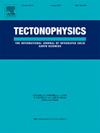在美国阿肯色州磁湾使用重力和磁力方法确定碱性碳酸盐岩复合体的地球物理特征
IF 2.7
3区 地球科学
Q2 GEOCHEMISTRY & GEOPHYSICS
引用次数: 0
摘要
磁湾碱性碳酸盐岩复合体(MCC)位于美国阿肯色州中南部的瓦奇塔山脉,拥有种类繁多的稀有岩石类型和重要的矿产资源,其物理性质(密度和磁化率)与其侵入的沉积岩形成鲜明对比。新获得的地基重力和磁力数据被用于开发白垩纪时期磁湾侵入复合体的二维和三维地球物理模型。模型显示,磁性海湾侵入体(1) 在中地壳深度扩大到 22 千米宽,深度可能达到 20 千米;(2) 总体积(裸露和地下)可能超过 800 千立方米;(3) 在深度上可能与阿肯色碱性矿带的其他侵入体相连;(4) 其几何形状与里尔富特裂谷和瓦奇塔造山带等先前存在的构造相一致,其中一些构造可能受前寒武纪结晶基底和埋藏在瓦奇塔造山带下的大陆-海洋过渡带的结构控制。MCC 的磁性模型首次考虑到了强剩磁的存在。这就产生了一个地球物理工作流程,它是准确解释更大的阿肯色碱性省的磁异常、其地质和结构框架以及关键矿产潜力所必需的。本文章由计算机程序翻译,如有差异,请以英文原文为准。
Geophysical characterization of an alkaline‑carbonatite complex using gravity and magnetic methods at Magnet Cove, Arkansas, USA
The Magnet Cove alkaline‑carbonatite complex (MCC), located in the Ouachita Mountains of south-central Arkansas in the United States, hosts an extensive variety of rare rock types and critical mineral resources with physical properties (density and magnetization) that contrast significantly with the sedimentary rocks into which they have intruded. Newly acquired ground-based gravity and magnetic data were used to develop two-dimensional and three-dimensional geophysical models of the Cretaceous-aged Magnet Cove intrusive complex. The models reveal that the MCC: (1) widens out at middle crustal depths to as much 22 km across, and may reach a depth of 20 km; (2) has a total volume (exposed and subsurface) that may be over 800 km3; (3) is likely connected at depth to other intrusions in the Arkansas alkaline province; and (4) has a geometry that is aligned with pre-existing structures such as the Reelfoot rift and the Ouachita orogenic belt, some of which were likely structurally controlled by the Precambrian crystalline basement and the continent-ocean transition zone buried beneath the Ouachita orogen. For the first time, the magnetic models of the MCC account for the presence of strong remanent magnetization. This results in a geophysical workflow necessary to accurately interpret magnetic anomalies over the much larger Arkansas alkaline province, its geologic and structural framework, and critical mineral potential.
求助全文
通过发布文献求助,成功后即可免费获取论文全文。
去求助
来源期刊

Tectonophysics
地学-地球化学与地球物理
CiteScore
4.90
自引率
6.90%
发文量
300
审稿时长
6 months
期刊介绍:
The prime focus of Tectonophysics will be high-impact original research and reviews in the fields of kinematics, structure, composition, and dynamics of the solid arth at all scales. Tectonophysics particularly encourages submission of papers based on the integration of a multitude of geophysical, geological, geochemical, geodynamic, and geotectonic methods
 求助内容:
求助内容: 应助结果提醒方式:
应助结果提醒方式:


